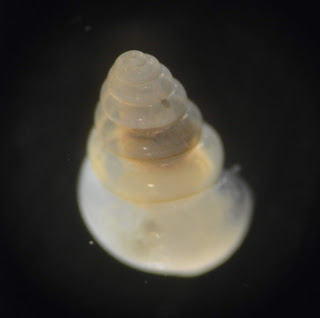Captured butterflies
I love larval traps. I love pouring out a dish full of preservative, scanning the clear liquid and seeing nothing with my naked eyes, wondering if there is a single organism in the sample. I love placing that same dish under the microscope, adjusting the focus, and being transported into a whole new world. I love the surprises that await me under magnification. I love finding preserved larvae, sorting them into categories by shape and size, then pulling out books to identify them. I love the process of discovery.
Today, I spent some time at the microscope going through larval trap samples from the Arctic. I built the traps myself at WHOI in 2017 and worked with German and Norwegian collaborators to deploy them on moorings in the Arctic. The first set of traps was collected in August of this year, after a year underwater.
I had no idea what I was going to find in my larval traps, so I excitedly cracked open my first sample. My eyes focused almost immediately on small, smooth snails - hundreds of them. I picked them out of the preservative, took photos, and set about identifying them. With the help of a colleague from Norway, I settled on the identification Limacina retroversa.
Limacina snails are actually not larvae; in other words, they're not baby snails that will eventually settle on the seafloor for their adult life. But they're interesting nonetheless. They're pteropods, or snails that spend their entire life in the water column, also called "sea butterflies." You might remember that I worked with a different species of pteropod, Limacina antarctica, when I was at McMurdo Station last January.
What's interesting about L. retroversa in my samples is that it's actually an Atlantic species. Usually, it's found in waters offshore of Europe, but in recent years, it's been penetrating farther and farther into the high Arctic thanks to warming temperatures and the northward-flowing West Spitsbergen Current. One of my German colleagues wrote a really good paper about how abundances of L. retroversa have been increasing in the Fram Strait over time, but I have something he didn't have - my samples were all deployed at the same time, but they're separated by space. With my samples, I can figure out just how far the Atlantic pteropods are penetrating into the high Arctic.
I was excited to find Limacina retroversa in my samples and look forward to a fun analysis!
Today, I spent some time at the microscope going through larval trap samples from the Arctic. I built the traps myself at WHOI in 2017 and worked with German and Norwegian collaborators to deploy them on moorings in the Arctic. The first set of traps was collected in August of this year, after a year underwater.
 |
| Limacina retroversa, photographed at 50x magnification |
Limacina snails are actually not larvae; in other words, they're not baby snails that will eventually settle on the seafloor for their adult life. But they're interesting nonetheless. They're pteropods, or snails that spend their entire life in the water column, also called "sea butterflies." You might remember that I worked with a different species of pteropod, Limacina antarctica, when I was at McMurdo Station last January.
What's interesting about L. retroversa in my samples is that it's actually an Atlantic species. Usually, it's found in waters offshore of Europe, but in recent years, it's been penetrating farther and farther into the high Arctic thanks to warming temperatures and the northward-flowing West Spitsbergen Current. One of my German colleagues wrote a really good paper about how abundances of L. retroversa have been increasing in the Fram Strait over time, but I have something he didn't have - my samples were all deployed at the same time, but they're separated by space. With my samples, I can figure out just how far the Atlantic pteropods are penetrating into the high Arctic.
I was excited to find Limacina retroversa in my samples and look forward to a fun analysis!
Comments
Post a Comment